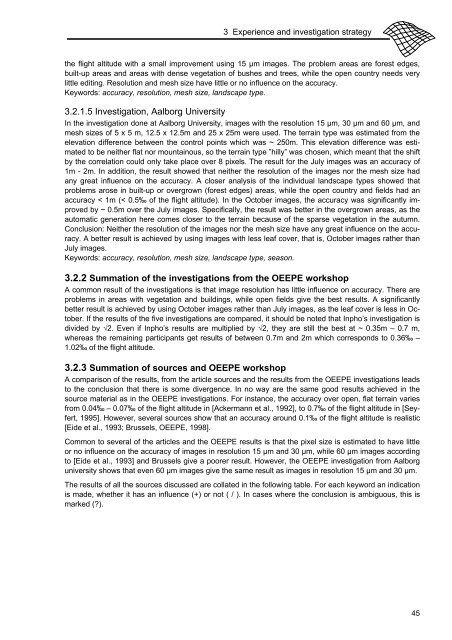Automatic generation of elevation data over Danish landscape
Automatic generation of elevation data over Danish landscape
Automatic generation of elevation data over Danish landscape
Create successful ePaper yourself
Turn your PDF publications into a flip-book with our unique Google optimized e-Paper software.
3 Experience and investigation strategy<br />
the flight altitude with a small improvement using 15 μm images. The problem areas are forest edges,<br />
built-up areas and areas with dense vegetation <strong>of</strong> bushes and trees, while the open country needs very<br />
little editing. Resolution and mesh size have little or no influence on the accuracy.<br />
Keywords: accuracy, resolution, mesh size, <strong>landscape</strong> type.<br />
3.2.1.5 Investigation, Aalborg University<br />
In the investigation done at Aalborg University, images with the resolution 15 μm, 30 μm and 60 μm, and<br />
mesh sizes <strong>of</strong> 5 x 5 m, 12.5 x 12.5m and 25 x 25m were used. The terrain type was estimated from the<br />
<strong>elevation</strong> difference between the control points which was ~ 250m. This <strong>elevation</strong> difference was estimated<br />
to be neither flat nor mountainous, so the terrain type ”hilly” was chosen, which meant that the shift<br />
by the correlation could only take place <strong>over</strong> 8 pixels. The result for the July images was an accuracy <strong>of</strong><br />
1m - 2m. In addition, the result showed that neither the resolution <strong>of</strong> the images nor the mesh size had<br />
any great influence on the accuracy. A closer analysis <strong>of</strong> the individual <strong>landscape</strong> types showed that<br />
problems arose in built-up or <strong>over</strong>grown (forest edges) areas, while the open country and fields had an<br />
accuracy < 1m (< 0.5‰ <strong>of</strong> the flight altitude). In the October images, the accuracy was significantly improved<br />
by ~ 0.5m <strong>over</strong> the July images. Specifically, the result was better in the <strong>over</strong>grown areas, as the<br />
automatic <strong>generation</strong> here comes closer to the terrain because <strong>of</strong> the sparse vegetation in the autumn.<br />
Conclusion: Neither the resolution <strong>of</strong> the images nor the mesh size have any great influence on the accuracy.<br />
A better result is achieved by using images with less leaf c<strong>over</strong>, that is, October images rather than<br />
July images.<br />
Keywords: accuracy, resolution, mesh size, <strong>landscape</strong> type, season.<br />
3.2.2 Summation <strong>of</strong> the investigations from the OEEPE workshop<br />
A common result <strong>of</strong> the investigations is that image resolution has little influence on accuracy. There are<br />
problems in areas with vegetation and buildings, while open fields give the best results. A significantly<br />
better result is achieved by using October images rather than July images, as the leaf c<strong>over</strong> is less in October.<br />
If the results <strong>of</strong> the five investigations are compared, it should be noted that Inpho’s investigation is<br />
divided by �2. Even if Inpho’s results are multiplied by �2, they are still the best at ~ 0.35m – 0.7 m,<br />
whereas the remaining participants get results <strong>of</strong> between 0.7m and 2m which corresponds to 0.36‰ –<br />
1.02‰ <strong>of</strong> the flight altitude.<br />
3.2.3 Summation <strong>of</strong> sources and OEEPE workshop<br />
A comparison <strong>of</strong> the results, from the article sources and the results from the OEEPE investigations leads<br />
to the conclusion that there is some divergence. In no way are the same good results achieved in the<br />
source material as in the OEEPE investigations. For instance, the accuracy <strong>over</strong> open, flat terrain varies<br />
from 0.04‰ – 0.07‰ <strong>of</strong> the flight altitude in [Ackermann et al., 1992], to 0.7‰ <strong>of</strong> the flight altitude in [Seyfert,<br />
1995]. However, several sources show that an accuracy around 0.1‰ <strong>of</strong> the flight altitude is realistic<br />
[Eide et al., 1993; Brussels, OEEPE, 1998].<br />
Common to several <strong>of</strong> the articles and the OEEPE results is that the pixel size is estimated to have little<br />
or no influence on the accuracy <strong>of</strong> images in resolution 15 μm and 30 μm, while 60 μm images according<br />
to [Eide et al., 1993] and Brussels give a poorer result. However, the OEEPE investigation from Aalborg<br />
university shows that even 60 μm images give the same result as images in resolution 15 μm and 30 μm.<br />
The results <strong>of</strong> all the sources discussed are collated in the following table. For each keyword an indication<br />
is made, whether it has an influence (+) or not ( / ). In cases where the conclusion is ambiguous, this is<br />
marked (?).<br />
45




